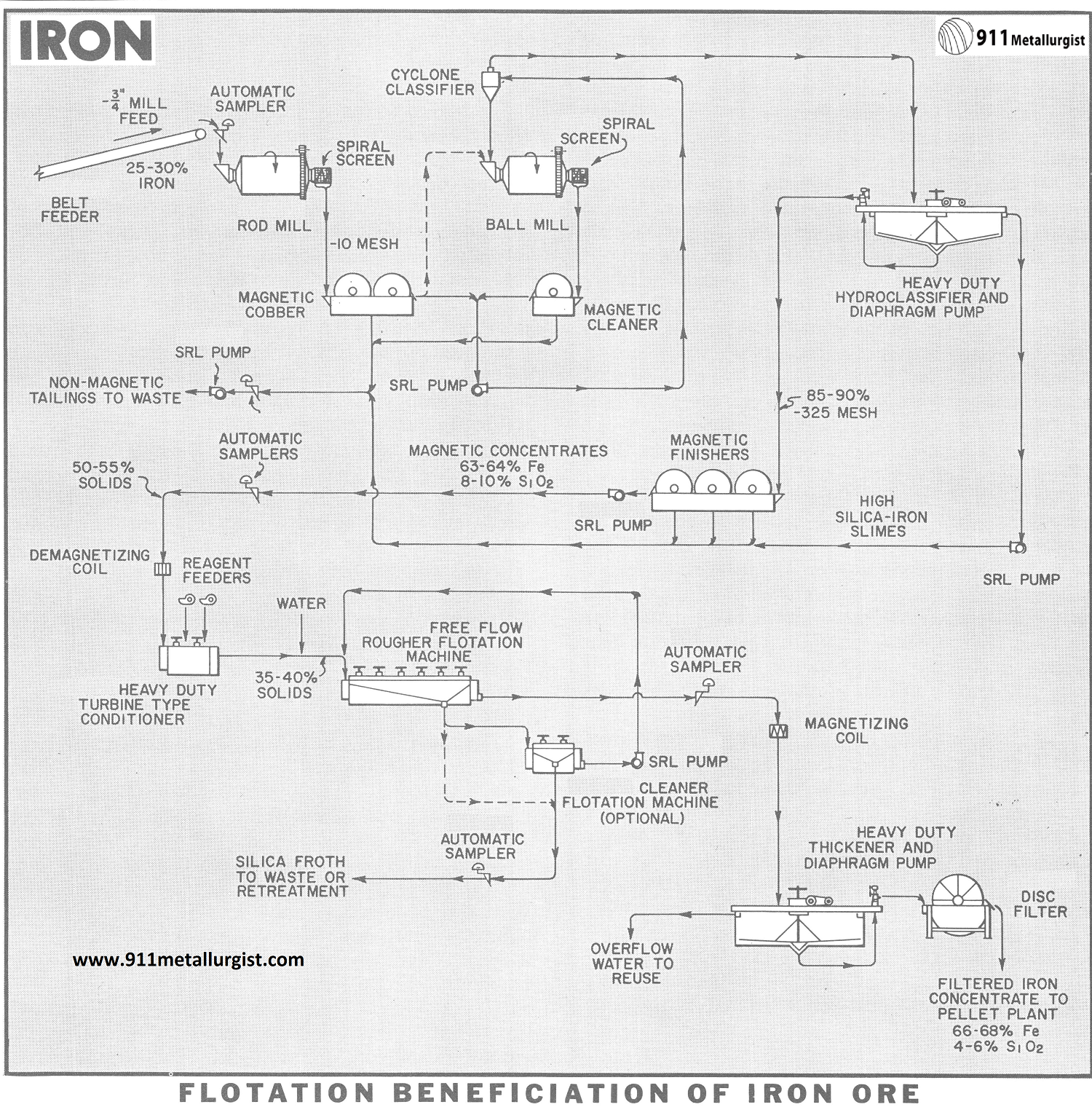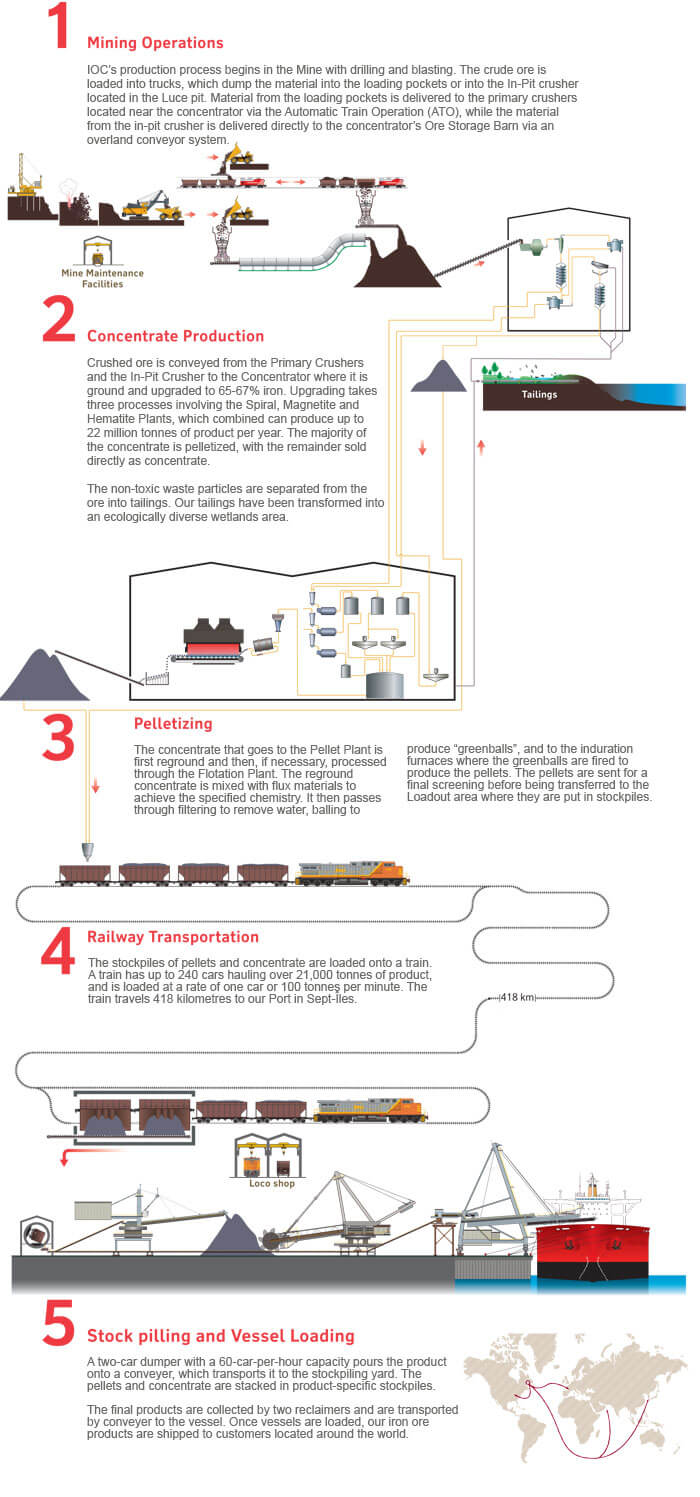Table of Contents
Beneficiation of Iron Ore and the treatment of magnetic iron taconites, stage grinding and wet magnetic separation is standard practice. This also applies to iron ores of the non-magnetic type which after a reducing roast are amenable to magnetic separation. All such plants are large tonnage operations treating up to 50,000 tons per day and ultimately requiring grinding as fine as minus 500-mesh for liberation of the iron minerals from the siliceous gangue.
Magnetic separation methods are very efficient in making high recovery of the iron minerals, but production of iron concentrates with less than 8 to 10% silica in the magnetic cleaning stages becomes inefficient. It is here that flotation has proven most efficient. Wet magnetic finishers producing 63 to 64% Fe concentrates at 50-55% solids can go directly to the flotation section for silica removal down to 4 to 6% or even less. Low water requirements and positive silica removal with low iron losses makes flotation particularly attractive. Multistage cleaning steps generally are not necessary. Often roughing off the silica froth without further cleaning is adequate.
The Iron Ore Process Flowsheet
The iron ore beneficiation flowsheet presented is typical of the large tonnage magnetic taconite operations. Multi-parallel circuits are necessary, but for purposes of illustration and description a single circuit is shown and described.
CRUSHING AND GRINDING
Crushing is done in the conventional manner in 2 or 3 stage systems to approximately all minus ¾ inch which is considered good feed for subsequent wet rod and ball mill grinding.
The primary rod mill discharge at about minus 10- mesh is treated over wet magnetic cobbers where, on average magnetic taconite ore, about 1/3 of the total tonnage is rejected as a non-magnetic tailing requiring no further treatment. The magnetic product removed by the cobbers may go direct to the ball mill or alternately may be pumped through a cyclone classifier. Cyclone underflows usually all plus 100 or 150 mesh, goes to the ball mill for further grinding. The mill discharge passes through a wet magnetic separator for further upgrading and also rejection of additional non-magnetic tailing. The ball mill and magnetic cleaner and cyclone all in closed circuit produce an iron enriched magnetic product 85 to 90% minus 325 mesh which is usually the case on finely disseminated taconites.
HYDROCLASSIFICATION AND MAGNETIC FINISHING
The finely ground enriched product from the initial stages of grinding and magnetic separation passes to a hydroclassifier to eliminate the large volume of water in the overflow. Some finely divided silica slime is also eliminated in this circuit. The hydroclassifier underflow is generally subjected to at least 3 stages of magnetic separation for further upgrading and production of additional final non-magnetic tailing. Magnetic concentrate at this point will usually contain 63 to 64% iron with 8 to 10% silica. Further silica removal at this point by magnetic separation becomes rather inefficient due to low magnetic separator capacity and their inability to reject middling particles.
Magnetic separation on average ores with 25 to 30% iron results in about 1/3 of the total tonnage ending up in final concentrate.
CONDITIONING AND FLOTATION
The iron concentrate as it comes off the magnetic finishers is well flocculated due to magnetic action and usually contains 50-55% solids. This is ideal dilution for conditioning ahead of flotation. For best results it is necessary to pass the pulp through a demagnetizing coil to disperse the magnetic floes and thus render the pulp more amenable to flotation.
Feed to flotation for silica removal is diluted with fresh clean water to 35 to 40% solids. Being able to effectively float the silica and iron silicates at this relatively high solid content makes flotation particularly attractive.
For this separation “Sub-A” Flotation Machines of the open or free-flow type for rougher flotation are particularly desirable. Intense aeration of the deflocculated and dispersed pulp is necessary for removal of the finely divided silica and iron silicates in the froth product. A 6-cell No. 24 Free-Flow Flotation Machine will effectively treat 35 to 40 LTPH of iron concentrates down to the desired limit, usually 4 to 6% SiO2. Loss of iron in the froth is low. The rough froth may be cleaned and reflotated or reground and reprocessed if necessary.
SILICA FLOTATION REAGENTS
A cationic reagent is usually all that is necessary to effectively activate and float the silica from the iron. Since no prior reagents have come in contact with the thoroughly washed and relatively slime free magnetic iron concentrates, the cationic reagent is fast acting and in some cases no prior conditioning ahead of the flotation cells is necessary.
A frother such as Methyl Isobutyl Carbinol or Heptinol is usually necessary to give a good froth condition in the flotation circuit. In some cases a dispersant such as Corn Products gum (sometimes causticized) is also helpful in depressing the iron. Typical requirements may be as follows:
Armac 12………………………………………..0.10-0.15 lbs/ton
Gum #9072……………………………………..1.0 lbs/ton
Heptinol…………………………………………0.025 lbs/ton
One operation is presently using Aerosurf MG-98 Amine at the rate of .06 lbs/ton and 0.05 lbs/ton of MIBC (methyl isobutyl carbinol). Total reagent cost in this case is approximately 5½ cents per ton of flotation product.
THICKENING AND FILTERING
The high grade iron product, low in silica, discharging from the flotation circuit is remagnetized, thickened and filtered in the conventional manner with a disc filter down to 8 to 10% moisture prior to treatment in the pelletizing plant. Both the thickener and filter must be heavy duty units. Generally, in the large tonnage concentrators the thickener underflow at 70 to 72% solids is stored in large Turbine Type Agitators. Tanks up to 50 ft. in diameter x 40 ft. deep with 12 ft. diameter propellers are used to keep the pulp uniform. Such large units require on the order of 100 to 125 HP for thorough mixing the high solids ahead of filtration.
ADVANTAGES OF FLOTATION
In addition to effective removal of silica with low water requirements flotation is a low cost separation, power-wise and also reagent – wise. Maintenance is low since the finely divided magnetic taconite concentrate has proven to be rather non-abrasive. Even after a year’s operation very little wear is noticed on propellers and impellers.
A further advantage offered by flotation is the possibility of initially grinding coarser and producing a middling in the flotation section for retreatment. In place of initially grinding 85 to 90% minus 325, the grind if coarsened to 80-85% minus 325-mesh will result in greater initial tonnage treated per mill section. Considerable advantage is to be gained by this approach.
Free-Flow “Sub-A” Flotation is a solution to the effective removal of silica from magnetic taconite concentrates. Present plants are using this method to advantage and future installations will resort more and more to production of low silica iron concentrate for conversion into pellets.
Source: This article is a reproduction of an excerpt of “In the Public Domain” documents held in 911Metallurgy Corp’s private library.

